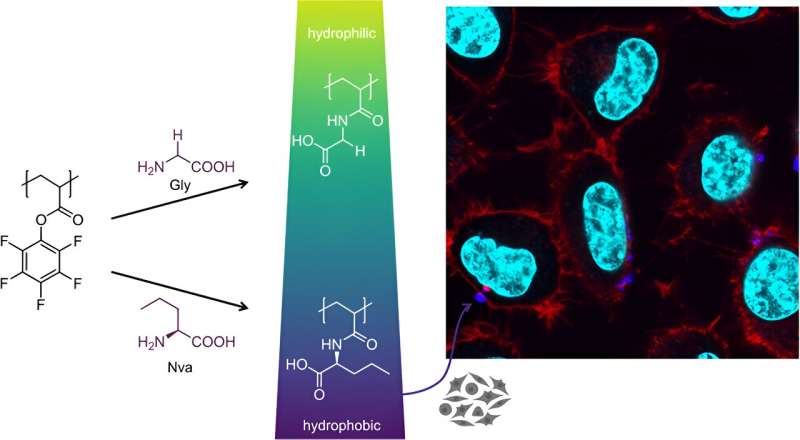This article has been reviewed according to Science X's editorial process and policies. Editors have highlighted the following attributes while ensuring the content's credibility:
fact-checked
trusted source
proofread
New polymers show interaction with cells

A new development in biomedical research could open the door to a variety of new applications: Scientists at the University of Bayreuth have found that certain polymers, called polyanions, can penetrate cells in a unique way without causing damage.
The study, which was published in the journal ACS Polymers Au, may help to transport active substances into cells in a more targeted manner.
A team of researchers led by Prof. Dr. Meike Leiske, Junior Professor of Macromolecular Chemistry at the University of Bayreuth, has investigated how polymers can be used to deliver active ingredients of drugs exactly to the place in the body where they are needed.
To this end, they have produced a new type of amino acid-functionalized polymer. Amino acids—organic compounds that make up proteins or hormones, for example—were attached to polymers. These novel polymers can bind slowly to cells and accumulate in the cell membrane. This opens up exciting possibilities for the development of new medical applications.
In the current study by Prof. Dr. Meike Leiske, Junior Professor of Macromolecular Chemistry at the University of Bayreuth, polyanions were produced that are derived from amino acids and have different alkyl side chains. These polyanions were produced using a special chemical synthesis method to obtain defined properties.
The researchers were able to show that these polymers have a similar ionic charge to the well-known polyacrylic acids, while they are hydrophobic, i.e., water-soluble, in different ways.
The interactions between these polyanions and cells were examined in detail, and it was found that the polymers bind slowly to the cells and can accumulate in the cell membrane. In particular, the polyanions with a higher hydrophobicity showed stronger binding to the cells.
"Normally, polyanions interact very slowly or not at all with our cells because, like our cell membrane, they also have a negative charge. By using slightly more hydrophobic amino acids, we were able to design the polymers in such a way that they embed themselves in the cell membrane—which does not normally happen—before they are finally taken up," explains Leiske.
This groundbreaking research shows the potential of polymers derived from natural amino acids. The diversity of these materials opens up new ways of adapting their properties for different medical purposes.
"The discovery that polyanions can enter cells in a gentle way without damaging them opens up new possibilities for biomedical research. This finding underlines that customized polymers, e.g., based on amino acids, could contribute to the development of innovative approaches for biomedical applications," says Leiske.
More information: Jonas De Breuck et al, Amino-Acid-Derived Anionic Polyacrylamides with Tailored Hydrophobicity–Physicochemical Properties and Cellular Interactions, ACS Polymers Au (2024). DOI: 10.1021/acspolymersau.3c00048
Provided by Bayreuth University





















